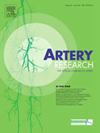P.05一种用于估计有效反射时间的新型质心方法的开发和验证
IF 1.6
4区 医学
Q4 PERIPHERAL VASCULAR DISEASE
引用次数: 0
摘要
背景:反射波到达中央动脉的时间对心室后负荷有重要影响。目前估计反射时间(RT)的方法,包括零交叉[1]、拐点[2]和足部[3]方法,仅使用压力波形上的单点,由于没有地面真实反射时间(GTRT)可用,其精度不确定。本文介绍了一种新的质心方法,该方法考虑了整个波形,并首次将RT方法的精度与GTRT方法进行了比较。本文章由计算机程序翻译,如有差异,请以英文原文为准。
P.05 Development and Validation of a Novel Centroid Method for Estimating Effective Reflection Time
Background: The time at which reflected waves arrive at central arteries has an important influence on ventricular afterload. Current methods of estimating reflection time (RT), including zero-crossover [1], inflection-point [2], and foot methods [3], use only a single point on the pressure waveforms, and their accuracy is uncertain because no ground truth reflection time (GTRT) has been available. We here introduce a novel centroid method that accounts for the entire waveform and compare the accuracy of RT methods by comparison with a GTRT for the first time.
求助全文
通过发布文献求助,成功后即可免费获取论文全文。
去求助
来源期刊

Artery Research
Medicine-Cardiology and Cardiovascular Medicine
CiteScore
1.70
自引率
16.70%
发文量
14
审稿时长
13 weeks
期刊介绍:
Artery Research is the official journal of the Association for Research into Arterial Structure and Physiology (ARTERY) which promotes the advancement of knowledge and dissemination of information concerning the pathophysiology, epidemiology, detection, investigation and treatment of arterial structure and function. The journal publishes original research articles, review articles, perspectives, case-studies, letters to the Editor, short communications and images. All submitted material is subject to a strict peer-review process.
 求助内容:
求助内容: 应助结果提醒方式:
应助结果提醒方式:


